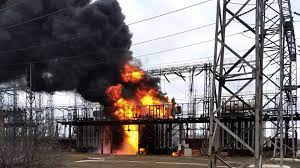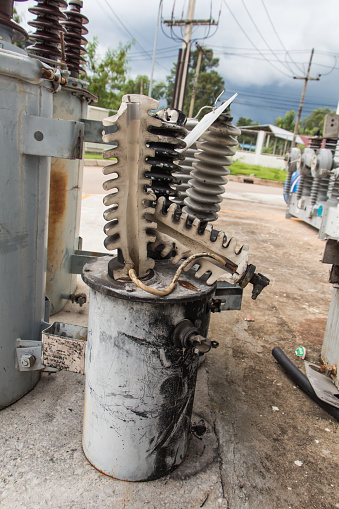How Many Concussions from Capitalists Can Americans Take?
America… just a nation of two hundred million used car salesmen with all the money we need to buy guns and no qualms about killing anybody else in the world who tries to make us uncomfortable.
— Hunter S. Thompson, “September,” Fear and Loathing: On the Campaign Trail ’72, p. 413.
Imagine, just how programmed are we, and this is it for an excuse?

So, the electricity will be shaky here, there, and everywhere. The excuse is, of course, supply chain. Ports are cloggged. Container ship chaos. They will not admit to the real reason for economic and spiritual collapse: CAPITALISM and PRICE gouging. It’s Putin’s fault.
Mass shootings, Roe v. Wade down the drain, empty shelves at hardware and food stores. It’s all Putin’s fault, including the price thieving for these electrical transformers, right? The $6 a gallon for gas in USA and $10 a gallon in Denmark, Putin’s fault. Mindless media midgets, and here we are: Western culture trapped in their own lies, inside their own self-fulfilling nightmares. Or continuous requiems for our dreams!

The lies and the shallow inquiries and the lack of curiosity, right up there with everyone is a used car salesman.
Journalism has always been dead in the mainstream:
The TV business is uglier than most things. It is normally perceived as some kind of cruel and shallow money trench through the heart of the journalism industry, a long plastic hallway where thieves and pimps run free and good men die like dogs, for no good reason.
Which is more or less true. For the most part, they are dirty little animals with huge brains and no pulse.
— Hunter S. Thompson, Generation of Swine: Tales of Shame and Degradation in the ’80s, November 6, 2003.
But back to other lies, and other lackeys lacking an inquiring mind. Local news from the local rag I publish my columns in, has stories about the local happenings. No pushback, just inverted triangle reporting. Referencing the local Public Utilities District here in Lincoln County:
Like utilities nationwide, Central Lincoln is being greatly challenged by supply chain delays, material shortages and massive cost increases for materials delivered. Demand for electrical supplies is robust, while transportation bottlenecks and raw material constraints are causing us significant concern over our ability to meet construction timelines. As we address these issues, Central Lincoln will strive to maintain supply levels to meet customer needs, while still maintaining emergency inventories.
We’ve all seen supply chain issues impact many aspects of life today. In some cases, lead times for Central Lincoln have increased six fold in the last two years when we’ve placed orders for materials. For example, new residential transformers typically took four months for delivery prior to the pandemic, and now they take between one year to 20 months to arrive. Costs for materials are also soaring — transformers that were $2,500 two years ago are now $15,000 each, and the cost is continuing to increase. This is not an exaggeration. (source)

Read that again: $2,500 for necessary transformers two years ago now SIX times more, at $15,000?
This is what defines USA, Biden, Trump, McConnell, Pelosi, Carson or Maddow, the entire shit show that is the American stupidity show. And how unprepared are we? This is the colonized mind, and this is the state of the American culture, as well as UK’s and Canada’s and EU’s. If all of this were true, and if we were guided (sic) by sane and humane folks, there’d be massive movements and masterful national plans to nationalize industries and rejigger the entire mess of capitalism for a world, a nation, that works for the people.
Now, shifting over to Scott Ritter, military lover, but still, smart. He’s not on mainstream TV, in mainstream news. Again, the plastic hair and the Botox lips and the grappling girdles on these airhead TV presenters match their plastic brains. Here (below), he talks about how stupid Americans are (about world issues), and that includes what Yanquis do not know or want to know about the Nazi Ukrainians and this special military operation that Russia FINALLY had to unleash on that disgusting Ukraine and that perverted Zelensky and his crew.
But before Scott’s interview, how about a little black robe insanity. Here we are now, with that un-Supreme Court, doing their shit show decision to get into the uterus of the female persuasion. Eichmanns, one and all.

Imagine that? Supreme (not) Court now determining the legality of obesity, the calories, the sorts of foods, the environmental effects on the male perusasion. Will the male be held criminally libel for what they ingest and what they do to their bodies, their sperm, the RNA?

Let’s be consistent here, perverts?
There is substantial evidence that paternal obesity is associated not only with an increased incidence of infertility, but also with an increased risk of metabolic disturbance in adult offspring. Apparently, several mechanisms may contribute to the sperm quality alterations associated with paternal obesity, such as physiological/hormonal alterations, oxidative stress, and epigenetic alterations. Along these lines, modifications of hormonal profiles namely reduced androgen levels and elevated estrogen levels, were found associated with lower sperm concentration and seminal volume. Additionally, oxidative stress in testis may induce an increase of the percentage of sperm with DNA fragmentation. The latter, relate to other peculiarities such as alteration of the embryonic development, increased risk of miscarriage, and development of chronic morbidity in the offspring, including childhood cancers. (source)
Preparing for American Roe v. Wade protests in DC. Imagine that, Plywood USA. DC Police Gauntlets. AmeriKKKa.
This all connects, really, these issues of local electrical power outages, and war. War against Russia, and, well, local costs soaring: War against the people. Supply chain excuses. Oh, where oh where are those Republican pukes and Democratic pukes serving us, the people? Electrical outages? Check that one failure of leadership for massive deaths and injuries in simple households?
Ritter talks about Nato using nuclear weapons, talks about the stupidity of Americans, and actors and the cultural cancelling.
Here you go, Gonzalo Lira: Israel Provokes Russia
Because I’ve lost access to all my accounts and channels to the SBU (Ukraine’s secret police), I don’t have any way to promote my content—so please be so kind as to share this video with anyone whom you think might learn something. GL
He talks about how Jews, not just Zionists and those in Occupied Palestine, seem to collectively hate Russians. It’s racism, of course, to hate an entire people: Russians? And, will this YouTube be taken down? For the opinion of Lira saying that Jews seem to hate Russians, or, for, another reason?
John Feffer wrote it, and he is bought and sold — co-director of Foreign Policy in Focus at the Institute for Policy Studies. He is a fellow at the Open Society Foundation and a member of the Democratic Socialists of America. The original article came from Tom Dispatch. Feffer is self-described Jewish gay.
Look up George Soros and his Open Society Foundation. Look up DSA’s stance on pouring weapons and death into Ukraine. DSA is all for billions of weapons to Ukraine, and billions for ZioLensky to “operate” the Ukraine government, err, Mafia. This is how these pencil necks see their world:
In its attempt to swallow Ukraine whole, Russia has so far managed to bite off only the eastern Donbas region and a portion of its southern coast. The rest of the country remains independent, with its capital Kyiv intact.
No one knows how this meal will end. Ukraine is eager to force Russia to disgorge what it’s already devoured, while the still-peckish invader clearly has no interest in leaving the table.
Here some comments at Scheer Post, pushing back on this guy, and I won’t republish mine:
Robert Sinuhe:
This is what happens when you are seriously ignorant of facts. He seems to know what Mr. Putin is thinking which should prompt Mr. Putin to ask this fellow what he’s thinking. Complete nonsense!
Roger Hoffmann:
What a disappointing read from Scheerpost. As others have already noted the repeated falsehoods (Russiagate) and baseless claims (Russia wants to swallow Ukraine) and others, I won’t waste the time addressing them either.
I will only say that it is apparent that this writer, in stating a narrative that overlaps much with that of Washington and its mouthpieces, seems oblivious to (or else, dishonestly chooses to ignore) much of the actual history of this conflict- the context in which it emerged, the pleas and warnings not only by Russia but of many seasoned U.S. officers from military, Intel and Diplomatic corps alike, and that of Russia-expert western scholars; and the actions of the U.S. since 2014 at least.
My advice to the writer: please don’t write about things that you know so little about, especially if you want to persuade those who’ve taken the time to become informed.
Terrence Bennett:
Tom Dispatch is a now sadly Pro Nazi source for regressives.
I urge Robert Scheer to monitor and reject many former progressives who now appear on organs like the late great Tom Dispatch
So, taking it in the rear? The back alley abortions. The behind the box store automobile trunk deals for prescriptions and diapers. The people have a choice in what money goes here and there? No massive strike, rolling strikes, rebellion? Our lives are gutted more and more each day!
Rents? Is that on the Republicans’ and Democrats’ agenda?
Gerardo Vidal, who has lived in the same apartment in Queens, New York, with his family for 9 years, recently received a $900-a-month rent increase this year.
“It means having to uproot my entire family, given the fact we’re still having a difficult time earning money due to the pandemic and loss of jobs,” said Vidal. “It’s unfair that we are being basically forced out of places we lived in for nine years and that landlords can get away with this.” (source)

We’ll finish with Richard Wolff, on Capitalism and US Empire now that USA-Klanada-EU-UK are dumping their weapons on the world, and then a Brit who has been in Donbass reporting on the ground:
“The Economic, Political and Social Crisis of the United States.” One hour!
Here you go, the Nazi Zio-Zelensky using USA-French-German-Nato weapons to, well, bomb neighborhoods, bomb apartment blocks, bomb universities, bomb bomb bomb, and there are NO military targets in these volleys.
Graham Phillips: “20+ Minutes in Donetsk Under Shelling Just Now – Uncensored, Love Donbass, do what you can to help Donbass.”
Reality therapy. So, those transformers cost so much, uh? How many transformers in Donbass have been imploded by the USA-UK-France-Germany? Keep reading:
“National Security State Censoring of Anti-Imperialist Voices… the Latest Phase of its Long-Term Strategy to Divide and Control the Left” on Dissident Voice, by Stansfield Smith
These secret US government and CIA operations have been detailed in The Mighty Wurlitzer: How the CIA Played America, Finks: How the C.I.A. Tricked the World’s Best Writers, The Cultural Cold War, and AFL-CIO’s Secret War against Developing Country Workers: Solidarity or Sabotage?
In 1977 Carl Bernstein revealed CIA interconnections with the big business media. More than 400 journalists collaborated with the CIA, with the consent of their media bosses. Working in a propaganda alliance with the CIA included: CBS, ABC, NBC, Time, Newsweek, New York Times, Associated Press, Reuters, United Press International, Miami Herald, Saturday Evening Post and New York Herald Tribune. The New York Times still sends stories to US government for pre-publication approval, while CNN and others now employ national security state figures as “analysts.”
Reuters, BBC, and Bellingcat operate similarly, participating in covert British government funded disinformation programs to “weaken” Russia. This involves collaboration with the Counter Disinformation & Media Development section of the British Foreign Office.
The CIA pays journalists in Germany, France, Britain, Australia and New Zealand to plant fake news. Udo Ulfkotte, a former editor at Frankfurter Allgemeine Zeitung, one of the largest German newspapers, showed how the CIA controls German media in Presstitutes: Embedded in the Pay of the CIA. Ulfkotte said the CIA had him plant fake stories in his paper, such as Libyan President Gaddafi building poison gas factories in 2011.
The CIA was closely involved with the long defunct National Students Association and with the trade union leadership. The AFL-CIO’s American Institute of Free Labor Development, received funding from USAID, the State Department, and NED to undermine militant union movements overseas and help foment murderous coups, as against President Allende of Chile (1973) and Brazil (1964), as well as defended the rule of their masters at home. This continues with the AFL-CIO Solidarity Center, which receives $30 million a year from NED.
The CIA created publishing houses, such as Praeger Press, and used other companies such as John Wiley Publishing Company, Scribner’s, Ballantine Books, and Putnam to publish its books. It set up several political and literary journals such as Partisan Review. This CIA publishing amounted to over one thousand books, mostly geared to a liberal-left audience, seeking to bolster a third camp left, and undermine solidarity with the once powerful world communist movement.
Ahh, those transformers:

No national movement to, well, nationalize the construction and deployment and installation of these valuable electrical units? Summer, heat, fridges, AC, fans, oxygen machines, well, you get how valuable electricity is and how dangerous disruption of it kill.
No Marshall Plan for that? For clinics in all neighborhoods? Social workers and counselors for millions of students? Aging in place adults, no help for them? All those with Complex PTSD?
Again, one little Oregon County, and, shit-show number 9,999,999, coming to a city-town-county-place near-by.
Footnote: So, I went to pick up some vital medications at the Walgreens in Newport. Lo and behold, that electrical outage a few days ago fried the Walgreens’ computer — here, in Newport, and then, in Lincoln City. So, there were people lined up, freaked out since some of their meds are, well, life saving. That’s it for America, and it will only get worse as I wait in a line of 20 at the small USPS office in Waldport, where signs say, “Don’t leave junk mail here since we do not have a janitor . . . We are short staffed so we have to cut Saturday pick up window services . . . Please be patient as we are understaffed.”
USPS, and Trump and Biden. Whew! Ben Franklin is turning in his grave. The light is out on his kite. Remember, USPS is a public service, and it is one foot in the grave:
What this report finds: The United States Postal Service is a beloved American institution that provides an essential public service to communities and good middle class jobs for workers. It is a model of efficiency and responsive to changing customer needs. But the conflicting demands made upon it by Congress and regulators put it in a precarious financial position even before the pandemic. Anti-government ideologues and special interests have long sought to privatize, shrink, or hobble the Postal Service. The Trump administration revived these efforts, spurred by the president’s opposition to mail voting and his animus toward Amazon, a major customer.
What needs to be done: The Biden administration and Congress must act to undo the damage and allow the Postal Service to adapt to meet unmet needs, including the revival of postal banking. (source)











